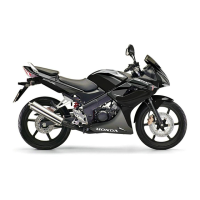
Do you have a question about the Honda CBR 125RW 2007 and is the answer not in the manual?
| Engine Cooling | Liquid-cooled |
|---|---|
| Engine Displacement | 124.7 cc |
| Bore x Stroke | 58.0 mm x 47.2 mm |
| Compression Ratio | 11.0:1 |
| Fuel System | PGM-FI electronic fuel injection |
| Ignition | CDI |
| Transmission | 6-speed |
| Final Drive | Chain |
| Front Suspension | 31mm telescopic fork |
| Front Tire | 80/90-17 |
| Rear Tire | 100/80-17 |
| Length | 1, 920 mm |
| Width | 675 mm |
| Height | 1, 070 mm |
| Wheelbase | 1, 294 mm |
| Seat Height | 776 mm |
| Engine Type | Liquid cooled 4-stroke, 2-valve single cylinder |
| Power | 10.2 kW (13.6 hp) @ 10000 rpm |
| Rear Suspension | Monoshock |
| Front Brake | Single disc |
| Rear Brake | Single disc |
| Fuel Capacity | 13 L |
| Dry Weight | 115 kg |
Key safety advice for riders, including wearing protective gear.
Guidelines for using and installing accessories and making modifications.
Explanation and location of safety labels on the motorcycle.
Visual guide to the location of all motorcycle controls and indicators.
Detailed explanation of all gauges and indicator lights on the instrument panel.
Instructions for operating key controls like ignition, start, stop, and lights.
Essential checks for rider readiness and safety before operating the motorcycle.
Recommendations for wearing appropriate protective gear for riding safety.
Instructions on how to safely park the motorcycle, including using the steering lock.
Advice on securing the motorcycle against theft.
Important considerations and safety guidelines when carrying a passenger or cargo.
Importance of maintenance, safety precautions, and overview of service tasks.
Information on tool kits, manual storage, and seat removal for maintenance access.
Recommended fuel type and octane rating for the motorcycle.
Information on the fuel tank capacity and when to refuel.
Step-by-step instructions for safely refueling the motorcycle.
Specifications for recommended engine oil type, viscosity, and standard.
Procedure for checking and adding engine oil to maintain proper level.
Instructions and precautions for changing the engine oil.
Recommended coolant type and mixture for the liquid cooling system.
Procedure for checking and adding coolant to the reserve tank.
Guidelines and recommendations for coolant replacement.
Procedure for draining deposits from the crankcase breather tube.
How to check and adjust the freeplay of the throttle grip.
Checks for proper throttle assembly positioning and smooth rotation.
Importance of proper clutch freeplay for smooth engagement.
Procedure for checking clutch freeplay and specifications.
Steps for adjusting clutch freeplay using the upper cable adjuster.
Steps for adjusting clutch freeplay using the lower cable adjuster.
Recommended spark plug types and heat ranges for optimal performance.
Steps for inspecting, checking gap, and replacing spark plugs.
Recommended brake fluid types for the braking system.
How to check brake fluid levels and when to consult a dealer.
Checking the front brake fluid level and other related inspections.
Checking the rear brake fluid level and other related inspections.
How to inspect brake pads for wear and when to replace them.
Importance of proper tire inflation and recommended pressures.
How to inspect tires for wear, damage, and foreign objects.
Recommendations regarding tire repair versus replacement.
Guidelines for replacing tires with correct specifications.
Procedure to test the side stand's effect on engine operation.
How to check drive chain slack and inspect for wear or damage.
Procedure for checking and adjusting drive chain slack.
Recommended lubricant and frequency for the drive chain.
Guidelines for drive chain cleaning and when replacement is needed.
Recommendations for storing the battery to maintain its service life.
Step-by-step instructions for safely removing the motorcycle battery.
Procedure for reinstalling the motorcycle battery.
Guidance on safely charging the motorcycle battery.
General advice for cleaning and maintaining the motorcycle's appearance.
Step-by-step guide for washing the motorcycle using mild cleaning agents.
Specific instructions for cleaning matte painted surfaces.
Recommendations for using spray cleaners on the motorcycle.
How to clean and maintain painted aluminum wheels.
Advice on using polishes and waxes for a finished look.
Comprehensive guide for preparing and storing the motorcycle for extended periods.
Instructions and safety advice for transporting the motorcycle.
Tips for environmentally responsible ownership and waste disposal.
General advice for handling problems encountered while riding.
Troubleshooting steps for engine starting problems.
Procedures and options for dealing with a flat tire.
Steps to take if the motorcycle's engine overheats.
How to check, replace, and troubleshoot blown fuses.
Safety advice and inspection steps after a motorcycle crash.
Procedures for dealing with a lost motorcycle key.
Advice for low or dead battery situations, and when to contact a dealer.
Information on VIN, engine serial number, and color label.
Key technical specifications including dimensions, capacities, and engine details.
Recommendations for the initial break-in period to ensure reliability.
Explanation of exhaust and crankcase emission control systems.
Information about the catalytic converter and its maintenance.
Guidance on using oxygenated fuels and their potential effects.
Information on ordering official Honda service and owner's manuals.
Overview of motorcycle warranties and owner responsibilities.
How to obtain warranty service and what is covered.
Advice on contacting Honda for support and resolving dealer issues.
Information on the services and products offered by Honda dealers.
Tips on proper maintenance to prevent expensive repairs.